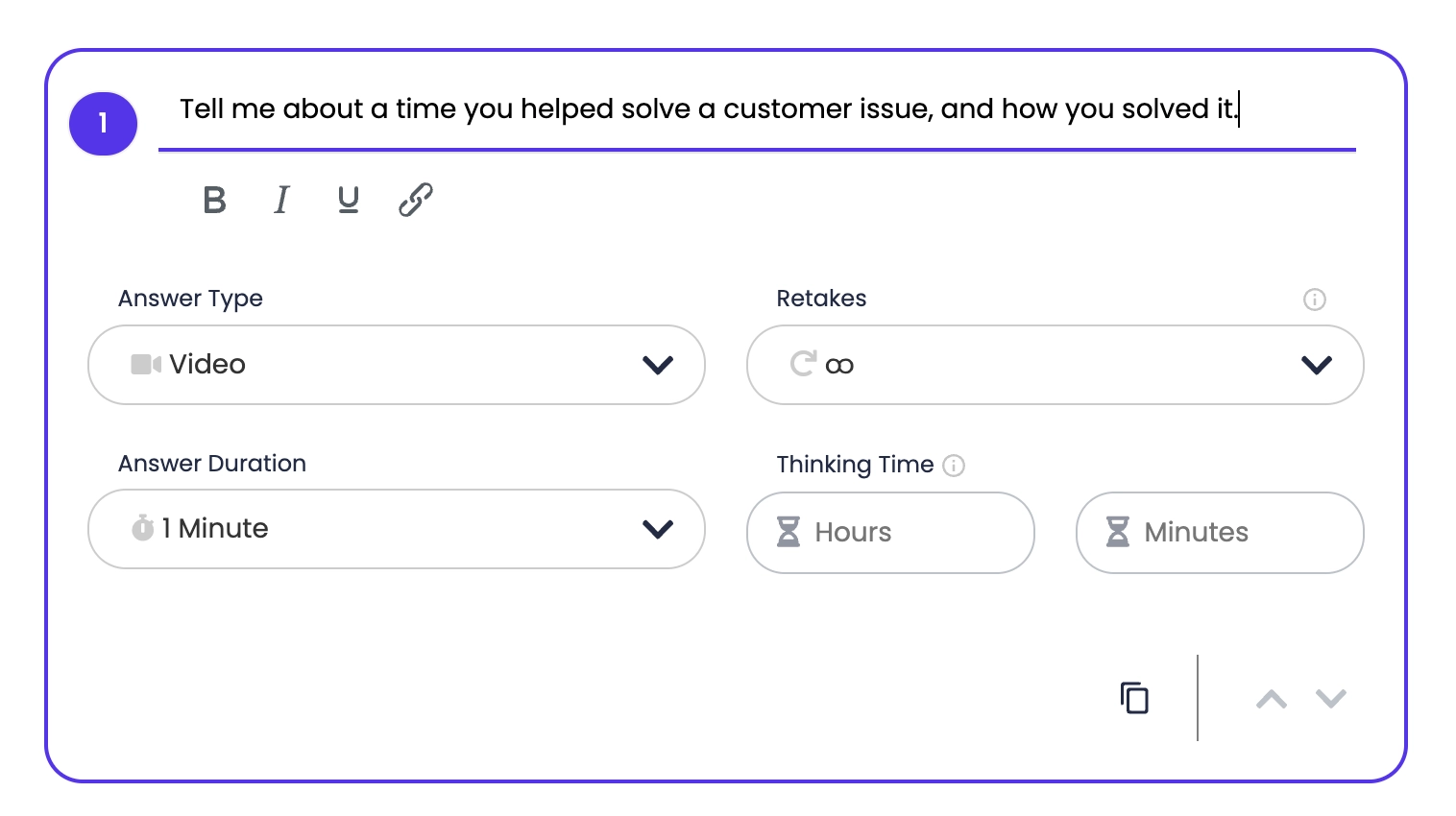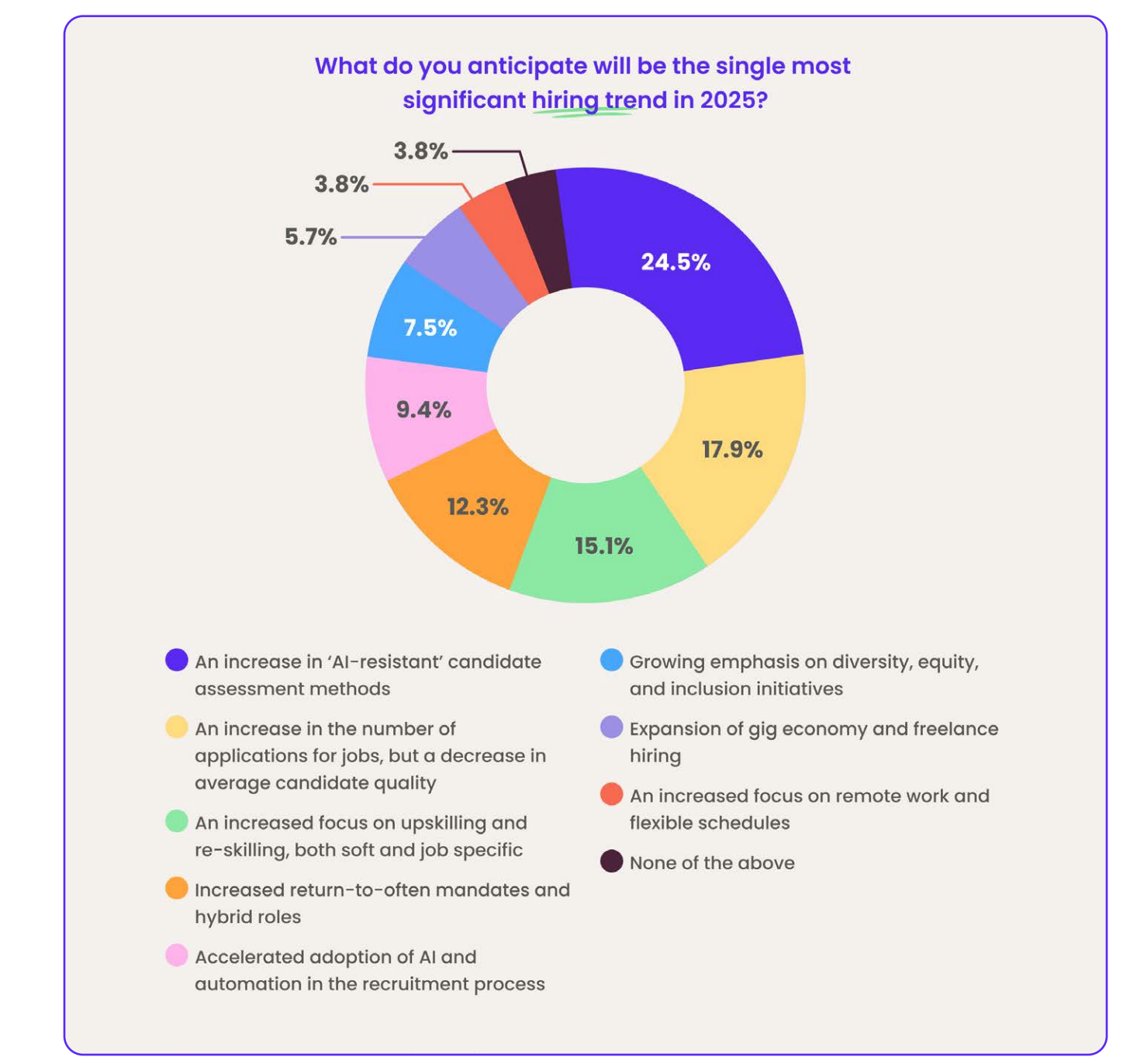TL;DR
To improve your recruitment process, identify where your hiring team faces inefficiencies: whether in tools, workflows, or decision-making. Then, assess how those inefficiencies impact the candidate experience and your ability to meet hiring goals. Lastly, use those insights to develop a recruitment improvement plan.
You're not alone in your search for recruitment process improvement strategies. Many hiring teams are pressured to hire faster, meet rising candidate expectations, and prove the ROI of every hire.
Yet:
- Roles are staying open for too long
- Candidate drop-off rates are rising
- Teams stuck juggling manual tasks, misaligned stakeholders, and unclear next steps
While there’s no shortage of recruitment improvement tips online, much of it fails to account for why hiring teams are currently facing a persistent talent shortage, burnout, and fierce competition for skilled workers, among other issues.
In this article, we examine six recruitment challenges hiring teams face in 2025– based on the latest research, and offer clear, practical solutions to resolve them.
Want to know what trends, concerns, and investments will define recruitment strategies this year? Get your copy of our 2025 State of Hiring Report.
Get a copy now
1. Automate time-wasting administrative tasks
In 2023, 71% of HR leaders reported that their organizations had missed a key candidate hire specifically due to inefficient hiring processes. Since then, new reports suggest that most hiring teams still struggle.
For instance:
- Hiring teams are still spending considerable time on low-value tasks like interview scheduling, and more than half of SMBs are not currently using applicant tracking systems.
- Manually screening resumes and pre-screening candidates is a highly prevalent activity for hiring managers.
- Drafting emails to candidates and providing consistent updates to job seekers about their application status are still manual efforts.
- Background checks being too slow and candidates failing them are reasons for not hiring otherwise offered candidates.
These issues and many others are causing inefficiencies in the hiring process and leading to burnout among HR leaders. 73% are experiencing it directly due to recruiting and hiring demands, with 61% considering quitting their jobs.
HR teams can solve these problems by strategically leveraging technology and adopting more efficient, people-centric processes.
Willo automates repetitive recruiting processes
Willo helps you automate candidate screening and management from start to finish, so you can focus on hiring the right people, faster. Here’s how the experience unfolds:
Source and screen candidates at scale
Start by inviting candidates in bulk, either from a curated list or directly from your sourcing platforms via seamless integrations. Candidates can complete their screening exercises anytime on any device—no apps or account sign-ups are required. It’s fast, simple, and accessible for everyone.
Let applicants book interviews on their terms
Once candidates complete their screening, they can show the days on which they would be available for an interview. The hiring manager then books an interview slot based on the candidate’s availability, keeping the hiring process moving with minimal coordination.
Keep communication smooth and consistent
Willo ensures candidates stay informed throughout the process. Use automated reminders and AI-generated emails to keep engagement high, even for candidates who don’t make it through. This process eliminates the risk of ghosting candidates and ensures you leave a positive employer brand in every candidate’s mind.
Built-in identity and right-to-work check
Do you need to verify your identity or right-to-work status? Willo’s built-in background checks and document verification tools reduce manual workload while keeping you compliant.
Quick shortlisting with AI
Willo Intelligence helps you quickly identify top candidates by filtering out those who don’t meet your criteria and summarizing key insights from candidate responses. It’s ideal for fast, high-quality decision-making—especially at scale.
Enable faster decisions with collaborative tools
With Willo's Showcase™ feature, hiring managers can review shortlists and video responses from a single link—no login is needed. Feedback is centralized and easy to act on, so decisions happen faster and everyone stays aligned.
Want to see how Willo works? Book a demo.
2. Prioritize a skills-based recruitment strategy
Talent shortage is slowing down recruitment. 45% of hiring leaders say it’s their biggest challenge. And, on average, it now takes 44+ days to fill a role, up from 31 days in 2023. These facts signal growing inefficiencies in traditional recruitment methods and a shift towards skills-based hiring.
Here’s why:
- Mass retirement: Over 10,000 Baby Boomers retire daily, leaving behind roles that younger candidates may not be fully trained to fill.
- Shifting skill requirements: AI and automation technology cause skill shortages by automating parts of an existing role and, thereby, creating new skill requirements. At the same time, skills that are difficult for AI to automate are becoming increasingly challenging to find.
- Increasing qualification gap: While traditional hiring practices focus heavily on formal qualifications, today's job market tells a different story. More than half of job seekers are interested in switching careers or industries, and 5% believe a college degree is the fairest way to determine hiring decisions.
About four out of 10 C-suite executives already report a shortage of workers with skills like critical thinking, problem structuring, and complex information processing. If left unaddressed, experts suggest the talent shortage will reach a critical mass by 2030.
Skills-based hiring can be an effective way to stand out in a tough hiring market.
At its core, it prioritizes a candidate's specific abilities and competencies over traditional credentials such as degrees or resumes. As a result, organizations can access a broader, more diverse talent pool, especially in a challenging talent-shortage market.
To implement skills-based recruitment, consider the following tips:
- Allow applicants to provide proof of prior work. For example, you could allow marketers to upload campaign reports, performance dashboards, and screenshots of their social media content.
- Incorporate practical, job-relevant tasks. Give candidates tasks that reflect the real work they’ll be doing on the job.
- Create a standardized evaluation framework so every candidate is assessed using the exact same criteria. This approach reduces bias and ensures a fair and consistent hiring process for all applicants.
These approaches create a competitive opportunity by enabling you to get ahead of the curve, access underutilized talent, and build a more adaptable, future-ready workforce.
Willo supports skills-based recruitment
Willo supports skill-based hiring by providing multiple response formats that let you thoroughly evaluate candidates for skills and potential:
- Use video responses to evaluate how candidates communicate and present ideas—skills that are often hard to judge from resumes alone.
- Assess candidates’ clarity, problem-solving, and attention to detail through written answers.
- Test job readiness by giving candidates practical, role-relevant tasks and letting them upload their completed work.
- Verify skills and experience by reviewing real work samples such as reports, presentations, or portfolios demonstrating their abilities.

And when evaluating, Willo helps your team stay fair and focused. Collaborative scorecards ensure everyone is assessed against the same criteria. Blind Scoring eliminates bias by letting team members score candidates independently before discussing results. The outcome is a more equitable and accurate assessment of who can succeed in the role.
3. Strengthen candidate interest with a compelling EVP and competitive benefits
As the pool of qualified candidates shrinks, top talents have more power to be selective about where they work. This shift has redefined what they expect from employers:
- Better benefits: 77% of employees say they’d accept a lower salary in exchange for superior benefits.
- Greater retention potential: 82% report they’d stay longer with a company that offers better health insurance.
- Purpose-driven culture: Candidates are now 2.5x more likely to be drawn to a company’s mission, values, and culture than just salary or perks.
On top of that, applicants are more skeptical of their potential employer’s reputation than ever.
In the past, catchy Employer Value Propositions (EVPs) could attract applicants, regardless of whether those promises matched internal reality. But 2025 candidates are more informed.

Thanks to anonymous reviews, word-of-mouth, and employee-generated content, they research companies for 30 minutes to 2 hours before applying. More than 70% of seekers would decline your application if they found a negative public reputation, whether due to bad press or employee feedback that contradicts your EVP.
So, what should you do?
- Top-down alignment: Ensure your leadership is not only clear on the company's mission, vision, and values but also committed to demonstrating them across all touchpoints.
- Authentic communication: Avoid isolated gestures like posting a photo of your diversity team if it’s not backed by inclusive practices. These optics can backfire when candidate research reveals a different reality.
- Strategic reputation management: Monitor and respond to feedback on platforms like Glassdoor, Reddit, and LinkedIn. Tap into your current employee network where false or outdated narratives exist to set the record straight and reinforce your authentic employer brand.
- Offer better pay and benefits: 38% of employees leave for roles with stronger compensation packages. Regularly benchmark your offers and communicate total rewards clearly to retain top performers.
According to LinkedIn, organizations with a strong employer brand see 50% more qualified applicants and reduce hiring costs by 43%. When your EVP reflects your actual workplace and meets modern candidate expectations, it becomes your strongest recruitment tool, not just a marketing line.
Showcase a positive EVP with Willo
Generic job descriptions and static content don't allow candidates to truly see or feel your company culture before applying. Willo empowers you to showcase and turn your EVP into a powerful talent magnet.
With Willo, you can set dynamic introduction videos or feature employee testimonials directly on your job application page, allowing candidates to hear directly from your team about what you stand for and the real day-to-day experience.
Furthermore, we support your candidates with friendly 24/7 live chat support in 18 languages worldwide, demonstrating that you truly "walk the talk" of being a candidate-friendly organization. This human-centric approach ensures a low-pressure, inclusive, and positive experience for every applicant, boosting completion rates and nurturing your employer brand.
4. Implement AI-resistant screening formats
From resume screening to interview prep, generative AI is now a staple in recruitment, but it’s also creating new inefficiencies. Candidates are using AI to craft polished job applications that may not reflect their actual capabilities.
As a result, employers are seeing:
- Higher application volumes
- Fewer stronger candidates
- Wasted interview hours on underqualified candidates
As Estelle McCartney, Chief Growth Officer at Arctic Shores, explains:
“Some recruiters are seeing a real drop in the quality of candidates at the interview stage versus what their assessment scores were earlier on.” (Hiring Humans: AI in Talent Report)
This creates a ripple effect: more time spent filtering, longer decision cycles, and a higher risk of losing genuinely strong candidates to faster-moving competitors.
To counter this, organizations are adopting AI-resistant assessments, formats that are difficult to fake with AI-generated content.

Examples include:
- Video responses explaining decisions or workflows
- Timed challenges requiring human reasoning
- Live interviews focused on practical problem-solving
This shift is already gaining momentum. Industry experts cite AI-resistant hiring methods as one of 2025’s most important trends, as they help ensure skills, not tools, make the hire.
Adopt an AI-proof screening with Willo
Willo provides an AI-proof screening solution that brings authenticity and originality into your screening process. With Real Talk, you can detect whether candidates are using scripted, AI-generated responses—even if they try to mask it with eye contact tricks or mix in real experience.
You can collect a mix of video, audio, written, and file-based responses to assess consistency in industry knowledge, job experience, and soft skills.
That means:
If a candidate paraphrases AI-written answers flawlessly in one format, this multi-format approach helps you spot inconsistencies by comparing the quality of responses in other formats.
As a result:
You can confidently measure true ability by looking beyond what a candidate says and tapping into their overall performance across every medium.
No more wasting hours on resumes and cover letters that look good on paper but reveal little about real capabilities. No more losing top talent in a pile of AI-generated applications.
Just fast and confident screening.
5. Ensure fair and ethical AI usage
The widespread adoption of AI in recruitment brings significant benefits, but it also introduces critical ethical and fairness challenges. Many talent professionals worry that too much AI in recruitment could make the process impersonal and cause them to miss out on top candidates.
Challenges include:
- The risk of algorithmic bias
- Selecting appropriate fairness metrics
- Ensuring job-specific requirements don't introduce bias
- Auditing large foundation models,
- The lack of standardized benchmarking and auditing procedures
These challenges have caused a notable shift in sentiment among talent professionals, according to the 2025 Hiring Trends Report. Compared to 2024, the share of professionals actively using AI in hiring dropped by 15 percentage points. Even more telling: the percentage of people who believe AI should never be used in hiring has more than doubled, from 4% to 9%.
This negative perception is not misplaced. The risk of bad AI usage is just far too harmful, especially when used for high-volume recruitment. You might be familiar with the MIT research that found that Google’s AI algorithm showed high-income job postings more frequently to men than to women.
But that doesn’t mean the end of AI usage in recruitment. Instead, this challenge presents an opportunity for forward-thinking and ethics-focused organizations. In fact, many recruiters are rethinking how they use AI, trying to balance AI’s efficiency and human judgment.
Here are some tips:
- Outline guiding principles for using AI. Explain what AI will help the team achieve, when it should be used, and strategies you’ll use to prevent bias.
- Be transparent with candidates. Let them know when and how AI is used in the hiring process. This builds trust and helps manage expectations.
- Continually organize workshops to train your hiring team on how to use AI ethically.
Also, consider adopting human-focused candidate screening tools like Willo.
How Willo helps
Instead of replacing your human decision with AI, Willo’s AI handles the repetitive and time-consuming parts of the hiring process, leaving the final decisions to humans. This gives you the best of both worlds: efficient recruitment and hiring decisions backed by human insight.
For instance, you can:
- Use prompts to automatically shortlist applicants who don’t meet your must-have criteria, saving hours on manual reviews.
- Search AI-generated transcripts to find specific details like industry knowledge or role-relevant experience.
- View a clear summary of strengths, weaknesses, and potential gaps to help you focus your follow-up interviews where it matters most.
- Create assessment questions based on the role and industry, ensuring you’re always asking relevant questions.
Want to see how others are doing it?
If you’re looking for inspiration from real hiring teams, check out our article:
4 recruitment process examples to inspire your approach.
You’ll hear how companies like SmartLynx, Trainline, Tyler ISD, and Lunio tackled challenges like candidate shortages, AI-generated applications, and cultural alignment—each with practical strategies you can adapt.
6. Build and nurture talent pools
When a critical role becomes vacant unexpectedly, most teams rush to fill the gap. But that often leads to rushed interviews, subpar hires, and longer time-to-productivity. The smarter approach is to build a talent pool before the need arises.
In fact, 91% of employers already proactively nurture future candidates, and for good reason. In a talent-scarce market, waiting until a role is empty puts you at a competitive disadvantage.
A well-maintained talent pool helps you:
- Reduce time-to-hire
- Lower the risk of bad hires
- Fill hard-to-replace roles faster
To build one, identify mission-critical or hard-to-fill roles, typically in leadership, technology, or specialized domains. Then apply these strategies to keep your pipeline warm and ready:
- Shortlist high-potential candidates: If you come across standout talent with no current opening, tag them in your ATS, track their availability, and check in periodically. Staying top of mind makes it easier to re-engage when roles open.
- Create internal talent pipelines: Don’t overlook your existing workforce. Identify high performers and groom them for leadership or niche roles through mentorships, rotational programs, or specialized training.
- Invest in early career programs: Design internships with strategic learning objectives (not just busy work). Pair them with entry-level programs that guide grads toward specialist or leadership tracks. This approach increases the likelihood that top interns convert to long-term hires.
- Partner with Educational Institutions: Engaging with universities, colleges, and vocational programs gives you early access to emerging talent and helps align them with your company culture and expectations from day one.
- Consider global talent initiatives: If local talent supply is constrained, global recruitment can significantly widen your talent pipeline to rare skill sets (e.g., engineering, product, data) and faster time-to-fill in tight labor markets.
PS: Spotting ambition, creativity, and trustworthiness in candidates with no track record is difficult. If you’re looking to attract graduate talent into internships or early career programs, Willo can help. With Willo, you can
- Instantly increase hiring success by expanding your talent pool with multiple sourcing techniques.
- Discover emerging talent through assessments that reveal true potential.
- Blend AI efficiency with human judgment to screen faster, without bias.
Want to learn more? See how Willo helps early-career employers screen graduate talent.
The right technology can enhance your recruitment process
The right technology removes delays and admin headaches that slow down your hiring and cost you great candidates.
Willo helps you move faster, reduce manual work, and stay in control of the key decisions. With structured assessments, anti-cheat protection, and bias-free evaluation, Willo helps you spot the best candidates quickly and hire them before competitors do, without sacrificing fairness.
The results speak for themselves:
- MyTutor increased the number of candidates it interviews per hour by 75% and reduced overhead by 12% with Willo.
- Travelxp reduced time-to-hire by 50%.
- Launchcode increased qualified candidates by 54% and completion rates by 22%.
- Bott + Co cut interview time by 45 minutes per candidate while improving new hire quality.
Frequently Asked Questions






